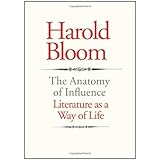
Average Reviews:

(More customer reviews)Are you looking to buy The Anatomy of Influence: Literature as a Way of Life? Here is the right place to find the great deals. we can offer discounts of up to 90% on The Anatomy of Influence: Literature as a Way of Life. Check out the link below:
>> Click Here to See Compare Prices and Get the Best Offers
The Anatomy of Influence: Literature as a Way of Life ReviewHarold Bloom is a polarizing figure. One finds it hard to reconcile this statement with the humble literary critic. But it is so.There are the Bloomdolators who bristle to the point of abusive invective if anyone dares suggest their idol has feet of critical clay and regularly pray to He-Who-Can-Do-No- Wrong (read some of the reviews here on Amazon if this you doubt). Then there are the naysayers who either ignore him, feel him outdated or those who want to take him seriously but find that whatever the topic it inevitably detours to Shakespeare and/or is punctuated by emphatic oracular statements unencumbered by any argument to support them. (Full Disclosure: I fall into the latter camp. Surprised?)
So why five stars? Because in many ways this book is different. It is Bloom's summa, pulling together everything from a lifetime of reading, of thinking about literature (with the emphasis on Shakespeare, naturally) and of thinking about literary influence. The tone is more elegiac than oracular. There is less of "this is what is" and more "this is what I've come to believe", a subtle shift that makes all the difference. This shading transforms the work into a synthesis of his well-earned subtitle: literature as a way of life.
His revisionist approach to his earlier (and most famous) work, THE ANXIETY OF INFLUENCE recall's Susan Sontag's similar motivations in revisiting ON PHOTOGRAPHY in her later REGARDING THE PAIN OF OTHERS, i.e. second and more informed thoughts. But influence (and agon) are not all that is on Bloom's mind (although it is the thread that winds through this book). Everything that he feels he wants to say about the various great works that have been important to him (his strong writers) are touched on, glancingly or at length.
The reader may need her dictionary handy to unpick words such as sprezzatura, tropological, misprision, topoi, prolepsis, acedia, and many others. And his love of mandarin prose has not been abandoned:
"There is an occult relation between Hamlet's long malaise and the play's unique and dazzling enigma, the gap cut in mimesis from act2, scene 2, through act 3, scene 2. We behold and hear not an imitation of an action but rather representations of prior representations. The covenant between stage and audience is abrogated in favor of a dance of shadows, where only the manipulator Hamlet is real. Destroying its own genre, the play thus gives us an unfathered Hamlet. Shakespeare scrambles after him, but Hamlet keeps getting away, Hobgoblin run off with the garland of Apollo." (page 65)
But if Bloom in these pages sees himself as an English Department of one, this book gives the impression rather of a mythical beast, glorious to behold, the last of his kind, sustained these many years by the nourishment of great books, great thinkers, great ideas who in the sunset of his generosity has decided to leave us the legacy of what he knows. I for one am sincerely grateful.The Anatomy of Influence: Literature as a Way of Life Overview"Literary criticism, as I attempt to practice it," writes Harold Bloom in The Anatomy of Influence, "is in the first place literary, that is to say, personal and passionate."
For more than half a century, Bloom has shared his profound knowledge of the written word with students and readers. In this, his most comprehensive and accessible study of influence, Bloom leads us through the labyrinthine paths which link the writers and critics who have informed and inspired him for so many years. The result is "a critical self-portrait," a sustained meditation on a life lived with and through the great works of the Western canon: Why has influence been my lifelong obsessive concern? Why have certain writers found me and not others? What is the end of a literary life?
Featuring extended analyses of Bloom's most cherished poets—Shakespeare, Whitman, and Crane—as well as inspired appreciations of Emerson, Tennyson, Browning, Yeats, Ashbery, and others, The Anatomy of Influence adapts Bloom's classic work The Anxiety of Influence to show us what great literature is, how it comes to be, and why it matters. Each chapter maps startling new literary connections that suddenly seem inevitable once Bloom has shown us how to listen and to read. A fierce and intimate appreciation of the art of literature on a scale that the author will not again attempt, The Anatomy of Influence follows the sublime works it studies, inspiring the reader with a sense of something ever more about to be.
Want to learn more information about The Anatomy of Influence: Literature as a Way of Life?
>> Click Here to See All Customer Reviews & Ratings Now
0 comments:
Post a Comment